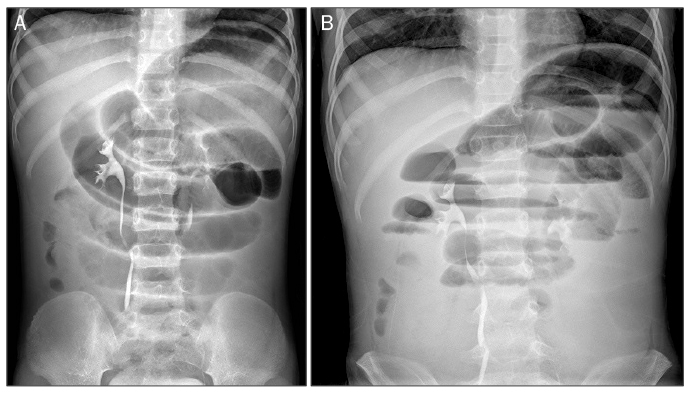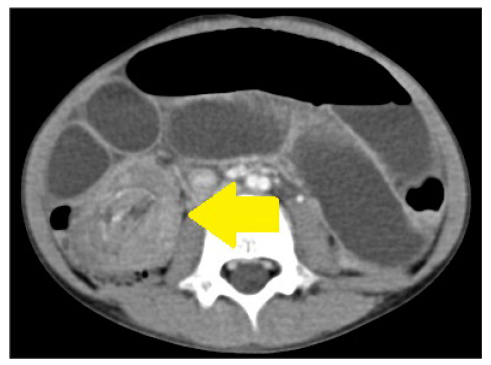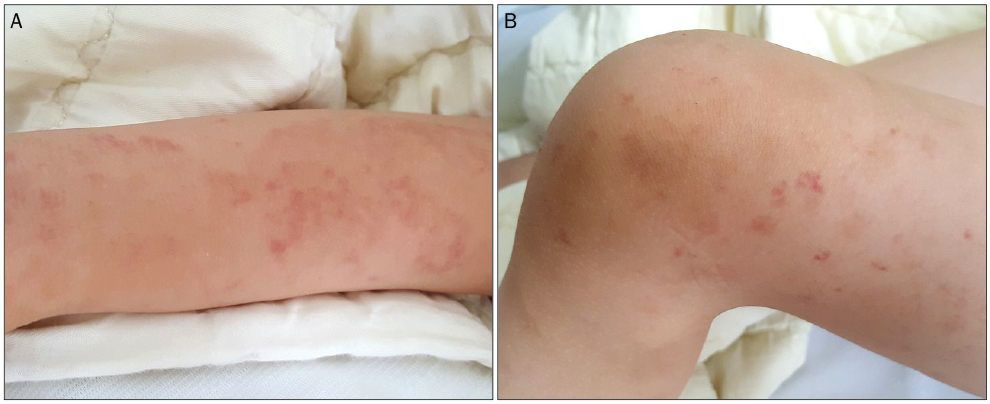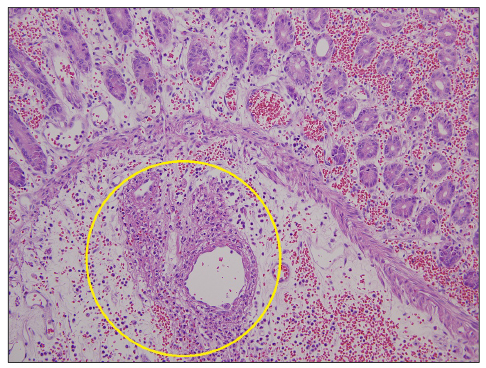Korean J Gastroenterol.
2017 Jun;69(6):372-376. 10.4166/kjg.2017.69.6.372.
Henoch-Schönlein Purpura Presenting as Intussusception
- Affiliations
-
- 1Department of Surgery, Wonkwang University School of Medicine, Iksan, Korea. saint@wonkwang.ac.kr
- 2Institute of Medical Science, Wonkwang University School of Medicine, Iksan, Korea.
- KMID: 2384366
- DOI: http://doi.org/10.4166/kjg.2017.69.6.372
Abstract
- Henoch-Schönlein purpura (HSP) is systemic vasculitis disease with various clinical manifestations. Gastrointestinal symptoms in patients with HSP are usually common, with an incidence rate of 62-90%. Most of these gastrointestinal symptoms occur after typical skin purpura, which is a very important clinical evidence for making a diagnosis of HSP. It is difficult to diagnose HSP without skin rash. About 25% of patients may experience gastrointestinal symptoms as their first symptoms. Herein, we report a case of ileo-colic intussusception associated with HSP in a 5-years-old girl presented with diffuse abdominal distension. Our patient did present any symptoms of HSP, such as purpura, arthralgia or arthritis, before surgery.
Keyword
MeSH Terms
Figure
Reference
-
1. Kim WS, Jeong JH, Lee JH, et al. Clinical manifestations of childhood intussusception with ubiquitous ultrasonography: comparison with small bowel and ileocecal type. J Korean Assoc Pediatr Surg. 2011; 17:23–34.2. Kim SH, Jung SM, Lee JI. Risk factors for surgical procedure on ileo-colic intussusception in children. J Korean Assoc Pediatr Surg. 2016; 22:10–13.3. Rai A, Nast C, Adler S. Henoch-Schönlein purpura nephritis. J Am Soc Nephrol. 1999; 10:2637–2644.4. Chen SY, Kong MS. Gastrointestinal manifestations and complications of Henoch-Schönlein purpura. Chang Gung Med J. 2004; 27:175–181.5. Esmaeili-Dooki MR, Moslemi L, Hadipoor A, Osia S, Fatemi SA. Pediatric intussusception in Northern Iran: comparison of recurrent with non-recurrent cases. Iran J Pediatr. 2016; 26:e3898. eCollection 2016 Apr.6. Zavras N, Tsilikas K, Vaos G. Chronic intussusception associated with malrotation in a child: a variation of waugh's syndrome? Case Rep Surg. 2016; 2016:5638451.7. Fernandes VP, Lomazi EA, Bellomo-Brandão MA. A rare association of intussusception and celiac disease in a child. Sao Paulo Med J. 2016; 09. 19. [Epub ahead of print].8. Saulsbury FT. Henoch-Schönlein purpura in children. Report of 100 patients and review of the literature. Medicine (Baltimore). 1999; 78:395–409.9. Choong CK, Beasley SW. Intra-abdominal manifestations of Henoch-Schönlein purpura. J Paediatr Child Health. 1998; 34:405–409.10. Seo MK, Hong J, Yim HE, Pai KS. A patient with Henoch-Schönlein purpura with intussusception and intractable nephritis. Child Kidney Dis. 2016; 20:92–96.11. Blanco R, Martínez-Taboada VM, Rodríguez-Valverde V, García-Fuentes M, González-Gay MA. Henoch-Schönlein purpura in adulthood and childhood: two different expressions of the same syndrome. Arthritis Rheum. 1997; 40:859–864.
- Full Text Links
- Actions
-
Cited
- CITED
-
- Close
- Share
- Similar articles
-
- Clinical Usefulness of Neutrophil-Lymphocyte Ratio as a Predictor of Henoch–Schönlein Nephritis
- A Case of Henoch-Schönlein Purpura Associated with Mycoplasma Pneumoniae Pneumonia
- A Case of Pulmonary Infarction Probably Related with Henoch-Schönlein Purpura
- Two Cases of Henoch-Sch nlein Purpura Presenting as Bullous Lesions
- Henoch-Schönlein Purpura Presenting as Mononeuritis Multiplex






